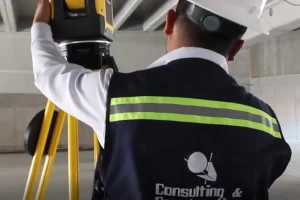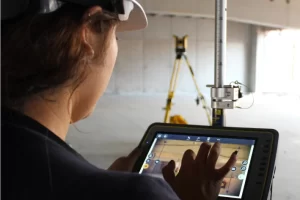
Construction is experiencing an unprecedented revolution by adopting robotic layout, a technique that redefines the standards of precision and efficiency in construction processes. This approach, supported by automation and millimetric precision, is transforming the way markings and point locations are done on construction sites.
The constant interaction between robotic stations and digital models, such as BIM models, constitutes the core of this methodology, ensuring perfect alignment between virtual design and tangible reality. This synergy between cutting-edge technology and practical execution sets a new standard for quality and efficiency in construction.

Construction is experiencing an unprecedented revolution by adopting robotic layout, a technique that redefines the standards of precision and efficiency in construction processes. This approach, supported by automation and millimetric precision, is transforming the way markings and point locations are done on construction sites.
The constant interaction between robotic stations and digital models, such as BIM models, constitutes the core of this methodology, ensuring perfect alignment between virtual design and tangible reality. This synergy between cutting-edge technology and practical execution sets a new standard for quality and efficiency in construction.
Robotic marking in construction stands out compared to manual and traditional field marking methods. This innovative technique uses automation and robotics to redefine the execution of markings and points in construction, focusing on precision and uniformity to achieve unprecedented levels of accuracy in contrast to conventional methods.
Effective communication between robotic stations and digital models is its main differentiator, ensuring perfect synchronization between the virtual design and its physical materialization. This reduces errors and improves alignment in construction projects. As robotic innovation transforms the industry, robotic marking becomes an essential component for improving efficiency and quality in contemporary construction, reshaping the industry landscape towards previously unexplored levels of precision and performance.

Robotic marking in construction stands out compared to manual and traditional field marking methods. This innovative technique uses automation and robotics to redefine the execution of markings and points in construction, focusing on precision and uniformity to achieve unprecedented levels of accuracy in contrast to conventional methods.
Effective communication between robotic stations and digital models is its main differentiator, ensuring perfect synchronization between the virtual design and its physical materialization. This reduces errors and improves alignment in construction projects. As robotic innovation transforms the industry, robotic marking becomes an essential component for improving efficiency and quality in contemporary construction, reshaping the industry landscape towards previously unexplored levels of precision and performance.
Creation of molds and formwork: Robots can perform the layout and marking of the exact shapes that molds and formwork for concrete must have. This allows for greater precision in the construction of concrete structures, which can improve their quality and strength.
Waste Reduction: Robotic tracing generates fewer residues and waste compared to manual tracing, thus decreasing the environmental impact of constructions and enhancing the project’s sustainability.
Automation minimizes human errors, enhancing quality and avoiding costly corrections in later stages.

Precision: Tracing robots operate with high accuracy, reducing the margin of error in task execution and enhancing the quality of the final work.
Speed: Being automated, robotic tracing is much faster than manual tracing, reducing project execution times and enhancing productivity.
Flexibility: Tracing robots can work on different types of projects and materials, increasing the flexibility of constructions and enhancing adaptability to clients’ needs.
Cost savings: By being more precise and faster, robotic automation reduces costs in labor and materials, resulting in a reduction in the overall project costs.
Safety: Being automated, robotic tracing reduces the risks of injuries and workplace accidents in construction, thereby enhancing worker safety.
At AEC Technology, we’re at the forefront of construction by offering a revolutionary robotic layout service. Our innovative solution redefines precision and efficiency in construction processes, bringing automation and cutting-edge technology to the heart of every project.
With robotic layout, we achieve high-quality results, error reduction, and precise execution that accelerates delivery timelines. Integration with digital models and uniformity in scale are just some of the advantages we provide, enabling seamless alignment between virtual design and tangible reality. Join us in transforming the construction industry and discover how robotic layout is taking efficiency and excellence to a new level.

